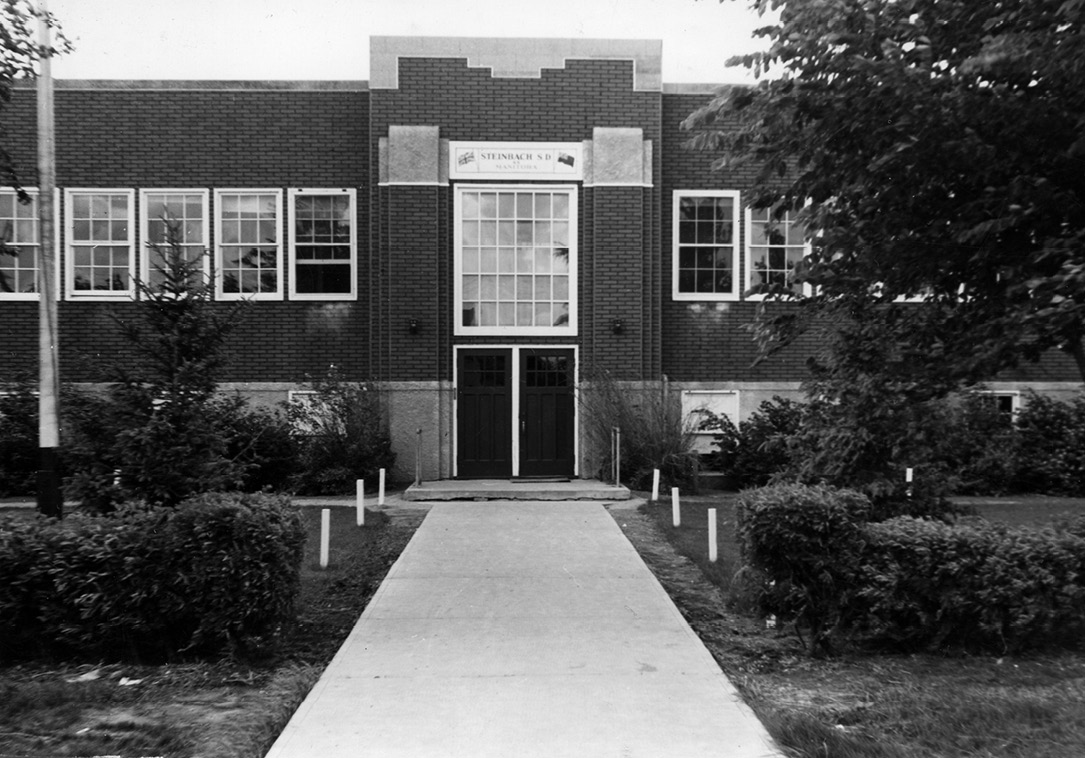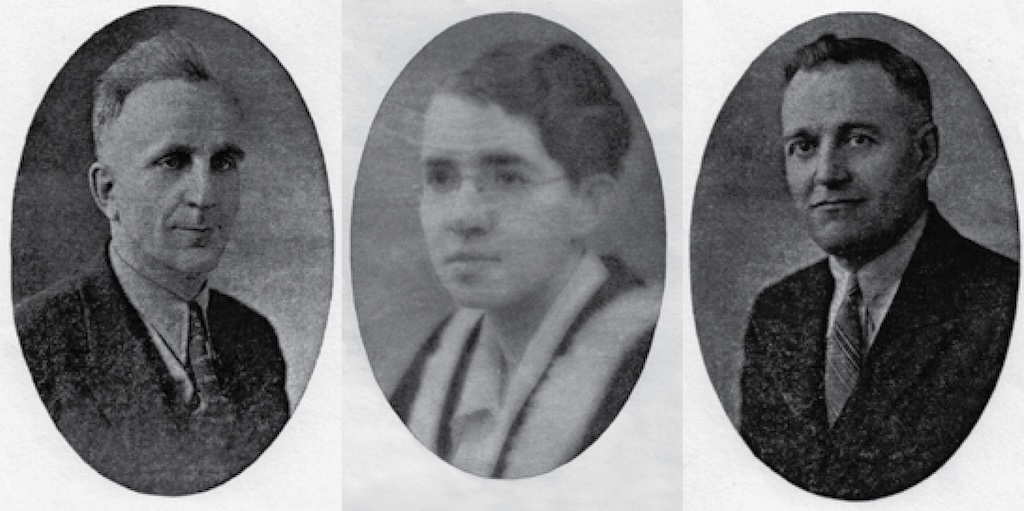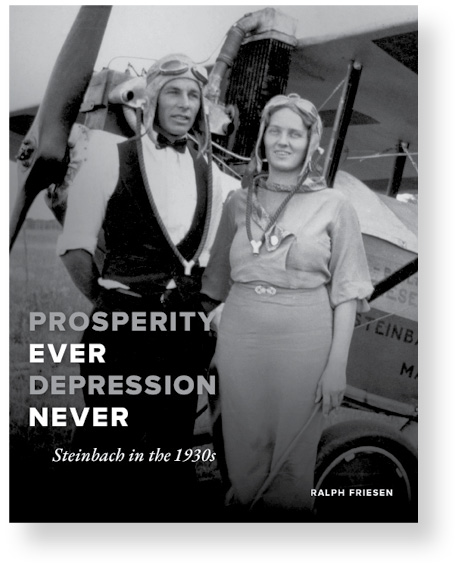“Prosperity Ever Depression Never”: Steinbach in the 1930s: An Excerpt
Ralph Friesen
As the growing population of Steinbach, Manitoba, and the surrounding district exerted more and more pressure for classroom space in the 1930s, trustees decided on the construction of a new building for a high school.1 It was recognized that, for years, “our high school students have had a hard time of it, in the basement [of the old school] with cold feet and warm heads, or squeezed together in a little room in the balcony [of the Mennonite Brethren church] or sent out to the distant territories or sheltered in abandoned store buildings, etc.” The school board called a public meeting in January 1936, and “136 versus 32 [attendees] voted for an expansion for the school, requiring six new classrooms.”2 Some ratepayers objected to spending such a large amount of money in hard economic times, but once the project had received approval, it moved ahead at a rapid pace. A $20,000 loan was floated from the Royal Bank, and Jacob F. Reimer, Isaac Wiens, and F. W. Sawatzky were engaged as head carpenters at thirty-five cents an hour, with Sawatzky earning an extra ten cents an hour as foreman. Excavation for the basement began in April 1936 at what was then Barkman Street (now 2nd Street) at the intersection of Reimer Avenue, west of Main Street. By September, “a large, handsome, well-lighted building stood ready for use.”3 The staff, all of whom had their bachelor of arts degrees, consisted of Julius Toews, principal (science, mathematics, and history), Jacob G. Kornelsen (German, science, mathematics, and history), and Linda Braun (English).
The physical fact of a high school building in Steinbach was also a powerful symbol, proclaiming that the village had endorsed advanced education and an increasingly urban – and secular – identity. Ten years earlier, Julius Toews had already issued a warning: “With the introduction of government schools it seems that a complete separation has occurred between school and church. The church has not only given up the internal management of the schools, but has also now renounced overseeing them.”4 Trustee and village historian K. J. B. Reimer, referencing Steinbach’s beginnings, urged students not to abandon their heritage and their faith: “Even if the time is different now than it was then, even if the curriculum of that time and today has hardly any similarity, true education of the heart and true Mennonite dedication to live righteously and have piety is still attainable today. We as a school authority strive to employ such teachers who will stand as role models in this respect.”5

The church’s influence was still felt, partly because the community hired only Mennonite teachers who could demonstrate a commitment to Christian principles. Also, religious exercises formed part of each school day. But the genie had been let out of the bottle. Steinbach’s schools followed the provincial government’s standard curriculum, and the students demonstrated little interest in the righteous living encouraged by K. J. B. Reimer.
The teachers are gently lampooned in Hedi Knoop’s novella Wenn die Erde bebt. “Mr. Loewen,” the principal, who teaches history and physics, is clearly a version of Julius Toews:
Mr. Loewen is a fine figure of a man, his large paternal face is framed by a full head of white hair. When he lets his intelligent eyes roam over the class, no one thinks of fidgeting or making paper balls. If he catches someone entertaining a wrong idea in their head, his devastating gaze hits that person, whose inner resistance immediately collapses.
In Knoop’s fictionalized version, three boys in her class – the school year would have been 1936–37 – are Toews’s sons, and “together with their father they own only one physics book.” As a result, lessons take on the quality of a Laurel and Hardy comedy routine:
“Which of you has the physics book with you today?” asks Mr. Loewen. “Do you, Greg?”
Greg searches through his pile of books.
“No, I don’t,” he says.
“You, Robert?” asks Mr. Loewen.
Now Robert dives under his desk and searches for a while. But in vain.
Benny is the laziest and rarely takes books home.
“Benny, how about you?” asks Mr. Loewen. Benny says no, but he also rummages laboriously through all his books.
Finally, Mr. Loewen searches his own pile in the teacher’s desk and, behold, he finds the book.
A marvelous amount of time has passed, but now the lessons can begin. “Turn to page 296,” says Mr. Loewen and begins to leaf through his book. He pages and pages. He also looks through all the loose pages. But page 296 is nowhere to be found.
A little helplessly, Mr. Loewen looks around the class. Then an older student comes to his aid and lends him his own physics book so that the lesson can finally begin.
But such mishaps do not diminish our respect for this teacher in the least. Even the fact that his history lessons consist of an hour of reading from a textbook does not prevent us from adoring him beyond measure.6

J. G. Kornelsen, on the other hand, was not so much adored as feared. He had bouts of rheumatism and could be irritable. If a student crossed a disciplinary line, he would threaten, “Das wird noch Blut kosten” (This will cost blood).7 Elizabeth Reimer, returning to Steinbach after taking her elementary schooling in an Anglo-Canadian community, found herself on the receiving end of Kornelsen’s wrath because of her weak grasp of German:
Somehow, I could not get the German articles right. One day the teacher, a German scholar with a passion for the language and a ferocious temper, shouted and waved me to the blackboard with his stick. “Der, Die, Das, Dem,” he screamed in my face until I was allowed to return to my seat.8
Kornelsen’s contribution to the inaugural high school yearbook was entitled “Lest We Forget,” and emphasized student indebtedness to their parents, “who have spent thousands of dollars to provide the necessary high school accommodation for you . . . at a time when the district [has] barely emerged from the worst effects of the Depression.” He went on to urge students to repay their debt by sacrificing “the trivial and transitory interests of the moment for greater and more permanent interests of life!”9
The “trivial interests of the moment,” then, as now, tended toward clowning and laughter. The unfortunate victim of this behaviour was Linda Braun, “tall, thin but large-boned, with sharp brown eyes and thick hair that curled to her shoulders.” She taught English for all four grades and so faced “mountains of homework each day, keeping up with all the correcting and reading.” In Wenn die Erde bebt, the author does not change her name but presents her as male: “Mr. Braun always comes to class well prepared. And yet during his lessons the boys fight in the benches, paper balls fly, Jack and William play Black Peter, the girls do their hair and Benny lets his alarm clock go off.” Somehow, Linda Braun survived these trials, and while “the boys harassed her mercilessly,” she connected well with the girls, modelling female independence by having her own apartment and a car and leading the girls’ choir.10

Ralph Friesen has contributed numerous articles to Preservings and is the author of Between Earth & Sky: Steinbach, the First 50 Years and Dad, God, and Me: Remembering a Mennonite Pastor and His Wayward Son, and co-author of Abraham S. Friesen, Steinbach Pioneer.
- This is an excerpt from Ralph Friesen, “Prosperity Ever – Depression Never”: Steinbach in the 1930s (Winnipeg: Manitoba Mennonite Historical Society, 2024). ↩︎
- G. G. Kornelsen, “Ostreserve-Nachrichten,” Steinbach Post, Jan. 22, 1936, 8. ↩︎
- Hilton Friesen and Ralph Friesen, Abraham S. Friesen, Steinbach Pioneer (Winnipeg: Hilton Friesen, 2004), 244; Steinbach Collegiate Institute yearbook (1937). ↩︎
- Julius Toews, “Schule und Kirche,” letter to the editor, Steinbach Post, Apr. 21, 1926, 1. ↩︎
- Steinbach Collegiate Institute yearbook (1937). ↩︎
- Hedi Knoop, Wenn die Erde bebt (Uchte: Sonnentau-Verlag, 1990), 102–3. ↩︎
- Leona Rempel, interview by the author, June 27, 2003. ↩︎
- Elizabeth Reimer Bartel, About Those Reimers: A Memoir (Kelowna, BC: Rosetta Projects, 2010), 147. ↩︎
- Steinbach Collegiate Institute yearbook (1937). ↩︎
- Bartel, About Those Reimers, 147; Knoop, Wenn die Erde bebt, 104; Rempel, interview. ↩︎
